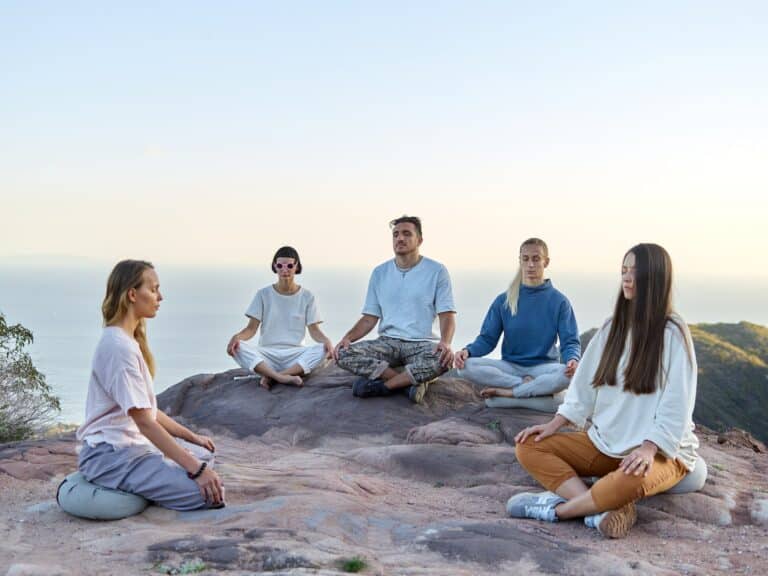Meditation changes our lives in powerful ways.
It lifts us out of the darkness of anxiety, depression, self-judgment, and unconsciousness, and fills us with peace, love, joy, and equanimity. It allows the fog of thoughts to clear, so we can see clearly, and feel connected with the Universe around us (and inside us).
Is it any wonder that we feel called to share the love, beauty, and bliss with others?
When I was in college, meditation saved my life. I had been spiraling into anxiety & despair… until one day a friend taught me to meditate. She gave me the tools to quiet my mind and live a happy, healthy life.
A few months later I met a girl on campus who struggled with the same kind of depression that I had recently risen out of. I showed her how to meditate, and I could see the change in her eyes immediately.
That was the first time I knew that I wanted to help people through meditation.
It took me years to become a meditation teacher, on a long and winding road, through a slew of other career paths, a bunch of monasteries and ashrams, and a lot of aimless wandering.
But becoming a meditation teacher doesn’t need to take you that long. It’s not hard or complicated to teach meditation, but it does require a few key things on your part: practice, presence, knowledge, confidence, skill, community, and strategy.
So to make this super simple for you, here are our…
7 Steps To Become A Meditation Teacher in 2023
1. Practice meditation every day
Cultivate your own daily meditation practice. Teaching meditation without having your own daily practice is as weak as it is hypocritical. Practicing meditation every day (ideally at the same time every day) forms the basis for your teaching practice, and for your own personal life as well.
2. Cultivate mindfulness, presence, compassion & loving-kindness
Cultivate your own personal mindfulness & presence by bringing your attention fully into the here & now, as you go about your daily life. When your mind wanders, just notice that it has wandered, and bring it back to the present moment. You can’t be a truly impactful and effective meditation teacher just by repeating some words from a meditation script. You need to lead by example, being here, inviting people gently to join you in the eternal now. At the same time, make sure to develop your empathy, compassion and loving-kindness, so that you can be sure to have a truly positive impact on the people you work with.
3. Expand your knowledge of meditation techniques from around the world
Learning one technique, style, or tradition of meditation in a deep way is a good start, and it can help you get on your feet. This type of deep dive can also work well if you want to be a monk in a monastery, or a teacher in a specific lineage. But if you want to be a versatile meditation teacher in the modern world, you’ll need a bit more of an extensive (as opposed to intensive) knowledge base. In order to serve the wide variety of needs in your community, it helps a lot to know a wide variety of meditation techniques, styles, and traditions from around the world. Specifically, I’d recommend learning at least one or two (preferably more) techniques from each of the four overarching categories of meditations: mindfulness, concentrative, breathwork, and spiritual. You may also want to learn how to work with different types of students/clients – children, adolescents, corporate clients, executives, traumatized individuals, etc. If you want to make a real career as a meditation teacher, it also helps to learn how to organize and host meditation classes, workshops, retreats, etc.
4. Hone your teaching skills
Your daily personal meditation practice, combined with your knowledge of various styles and techniques, will help you develop a powerful internal skill-set for meditation. If you want to teach meditation to others, you’ll also need to hone your teaching skills. Like your internal meditation skills, the equation for developing your meditation teaching skills is the same: knowledge + practice. When you have the knowledge of how to guide people into different kinds of meditative states, how to teach meditation to different kinds of clients, and how to avoid activating underlying mental-health issues that specific people might have (like trauma, dissociation, or schizophrenia)… then you can begin to practice teaching meditation in powerful, safe, and effective ways. At that point, it’s just a matter of practice, practice, practice. The more you practice, the more you develop your skills at teaching meditation.
5. Build your confidence
Many new meditation teachers get held back, and tripped up, by “impostor syndrome.” Impostor syndrome is a type of insecurity that arises when people feel like they’re not good enough, or not qualified, to be doing the things that they are doing. You may find yourself teaching a class, and wonder if you’re really qualified to be teaching meditation to the people in front of you. You may find yourself guiding a meditation, and wonder if you’re doing it correctly or leading people astray. While this type of self-doubt and insecurity can actually be a good thing in certain cases (for example, if you put on a white coat, walk into a hospital, and try to perform surgery), it is usually counterproductive for meditation teachers. Once you have cultivated your own daily meditation practice, deepened your presence, expanded your knowledge, honed your skills, and practiced teaching, you’re truly qualified to be a meditation teacher. Over time, as you continue to guide more and more people into meditative states, you’ll see their lives changing for the better. The proof will be in the results. Your confidence will develop naturally, and impostor syndrome will fade away, like a cloud into clear blue sky.
6. Connect with your sangha (community)
If a meditation teacher teaches in the forest, and nobody is around to hear it, did she really teach? The Buddha’s three Jewels included not only Buddha (awakened consciousness) and Dharma (teachings/knowledge), but also Sangha (community). If your heart is not woven into the fabric of a community, you can teach meditation to random individuals, but you’ll have a hard time growing. A healthy, holistic community includes not only people who can learn from you (students, clients, etc), but also people you can learn from (teachers, mentors, etc), and people you can relate to (peers, fellow teachers, etc).
7. Develop a career strategy and execute it
Some careers are simpler than others. If you want to become a lawyer, you take the LSATs, you go to law school, and you get a high-paying job when you graduate. If you want to become a doctor, you take pre-med courses, go to medical school, do an internship, and residency. If you want to become a professor, you go to graduate school, do research, defend your thesis, get a PhD. In all of these cases, you’re told what to do all along the way. You’re given the road map, and all you need to do is execute. Well, becoming a professional meditation teacher isn’t always as straight-foward. Yes, you may be one of the lucky few to get hired as a full-time meditation teacher by a yoga studio, an online platform, or a large company, but more likely, you’ll need to develop an independent practice. That means cultivating a client base, developing workshops & courses, and building your own business. You may live in a city that can support a thriving meditation studio, or you may live in the countryside and need to build your business completely online. You may decide to become a licensed therapist or psychologist so that you can accept a wider variety of health insurance plans. Taking into account your own personal life circumstances, challenges and opportunities, you’ll need to develop a practical career strategy, and execute on it, proactively and persistently, over time.
You can do this!
I know that this can seem like a daunting task, but I want you to know, it is doable. I personally earn $150 per hour for personal meditation coaching (though I spend most of my time building Meditation Magazine, The Meditation Organization, and Meditation University). I have many colleagues who make $100k+ as full-time meditation coaches, and the top teachers in the field make millions of dollars per year.
But teaching meditation is not some get-rich-quick scheme. If money is your main motivating factor for becoming a meditation teacher, I would advise you to stop now and go into a different field. There are many fields that are much easier to make money in. Building a full-time practice as a meditation teacher is not for the faint of heart. It requires passion, persistence, and dedication… and most of all, a deep and abiding love for the practice of meditation.
It may take you months, or years, to build up your meditation teaching practice to provide you with a livable, sustainable income… it all depends on how effective your career strategy is, and how diligently and efficiently you work to implement it.
But fear not. If you are a passionate meditator, and your calling in life is to help people become happier, healthier, and more awakened through meditation, then you will likely feel extremely fulfilled and satisfied as a professional meditation teacher. Your income streams may take time to develop, but you’ll start seeing the results immediately in your students and clients. You’ll feel the deep fulfillment from the smiles on their faces right away.
If you’d like more help in getting started…
If you’d like us to help you become a professional meditation teacher (or if you’re already teaching but want help in developing your practice, presence, knowledge, confidence, skills, community, or strategy) please let us know by sending us a message through the blue “chat” icon on the bottom-right corner of this page.
Our meditation teacher training program is one of the best in the world, with twelve master trainers teaching you dozens of powerful meditation techniques, and giving you abundant opportunities to practice teaching meditation and promote your services to Meditation Magazine’s 20k+ followers and subscribers.
Just DM us via the blue chat icon at the bottom right of this page – or email us at [email protected] – so we can discuss your personal situation, consider where you’re at now and where you want to go, and figure out if we can help accelerate your process of becoming the professional meditation teacher that you’ve been called to be ❤️










Meditation (Vipassana Meditation) has helped me gain more peace and equanimity in my life. Meditation will develop your intuition, make you more alert, increase will power and make you less aggressive
Meditation is a great way to improve your life, to feel more awake. i did that and i feel improvement too. That i why i am sharing some meditation tips for beginners.
Keep Meditating
This website gave me great tips how to become a meditation teacher I really always wanted to become one but I couldn’t find the right website but this website inspired me even more
thank you
… [Trackback]
[…] Info on that Topic: meditationmag.com/blog/become-a-meditation-teacher/ […]
… [Trackback]
[…] Find More here to that Topic: meditationmag.com/blog/become-a-meditation-teacher/ […]
… [Trackback]
[…] Find More on on that Topic: meditationmag.com/blog/become-a-meditation-teacher/ […]
… [Trackback]
[…] Read More on that Topic: meditationmag.com/blog/become-a-meditation-teacher/ […]
… [Trackback]
[…] Info to that Topic: meditationmag.com/blog/become-a-meditation-teacher/ […]
… [Trackback]
[…] Read More to that Topic: meditationmag.com/blog/become-a-meditation-teacher/ […]
It’s an excellent resource for learning new things. Your article is quite informative and baldi valuable.
Some people even claim that when they start with meditation, they start seeing angel numbers after breakup.
… [Trackback]
[…] There you can find 27728 more Information to that Topic: meditationmag.com/blog/become-a-meditation-teacher/ […]
… [Trackback]
[…] Read More here on that Topic: meditationmag.com/blog/become-a-meditation-teacher/ […]
… [Trackback]
[…] Here you will find 31960 additional Info on that Topic: meditationmag.com/blog/become-a-meditation-teacher/ […]
I found the post to be good. The shared information are greatly appreciated
… [Trackback]
[…] Find More to that Topic: meditationmag.com/blog/become-a-meditation-teacher/ […]
… [Trackback]
[…] There you can find 92009 more Information to that Topic: meditationmag.com/blog/become-a-meditation-teacher/ […]
… [Trackback]
[…] Find More to that Topic: meditationmag.com/blog/become-a-meditation-teacher/ […]
… [Trackback]
[…] Read More Information here to that Topic: meditationmag.com/blog/become-a-meditation-teacher/ […]
… [Trackback]
[…] Here you will find 52762 additional Info on that Topic: meditationmag.com/blog/become-a-meditation-teacher/ […]
… [Trackback]
[…] Find More here to that Topic: meditationmag.com/blog/become-a-meditation-teacher/ […]
… [Trackback]
[…] Read More on that Topic: meditationmag.com/blog/become-a-meditation-teacher/ […]